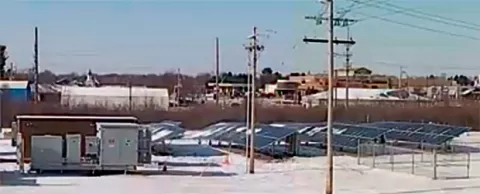
Do you want your city to be resilient in the face of natural and man-made disturbances? Do you want to gradually increase your use of distributed (local) renewables? In both cases, microgrids will be essential to your success.
The electric power industry has been piloting microgrids for more than a decade, and now the pieces are coming together. Consider the release below from Council Lead Partner S&C Electric (which also chairs the Council's Utilities Advancing Cities Task Force). As you'll read, they've put up a truly "utility-grade" microgrid.
Over time, you'll want microgrids scattered throughout your city in areas that house key assets such as hospitals, campuses, power-dependent businesses, emergency shelters and so on. And you'll want it to share these seven features:
- Supports multiple sources of local generation, including solar, wind, natural gas and legacy diesel generators
- Islands itself instantaneously in the event of a grid failure, relying on that local generation to continue serving critical loads
- Maintains utility-grade ancillary services even when the main grid is offline
- Seamlessly reconnects to the main grid when power comes back
- Includes significant energy storage (batteries)
- Uses energy storage to smooth the renewables (moderating their peaks and valleys)
- Strong cybersecurity
Where to put your first microgrid? This one is at University of Illinois Urbana-Champaign, where it can also be used for research. But some cities are considering microgrids for underserved neighborhoods. Many businesses require high-speed Internet and always-on power. If you can bring both to a neighborhood, you may be able to attract businesses and jobs to a district that needs the help. — Jesse Berst
S&C Electric Company, a smart grid leader shaping the future of power delivery announced today that it has provided the intelligent automation and control systems for Ameren Corporation’s microgrid facility in Champaign, Illinois. Located at Ameren’s Technology Applications Center (TAC) near the University of Illinois campus, the Ameren microgrid provides multiple sources of distributed generation - solar, wind, natural gas and battery storage - as well as advanced automation to support the TAC and a 1 MW residential load.
In the event of a power outage, the Ameren microgrid will use S&C’s intelligent automation and secondary controls from IPERC, S&C’s recently acquired wholly-owned subsidiary, to island from Ameren’s grid. The microgrid will use the available generation resources and energy storage to reform the grid in order to provide stable, long-term power to residents and businesses. During normal operation, the microgrid uses the on-site generation resources to optimize the efficiency of the power system and allow Ameren to test how to aggregate distributed energy sources and serve live customer loads on an actual utility distribution feeder. One unique feature of the Ameren microgrid is its ability to seamlessly transition customers back to the utility grid after islanding, without customers experiencing an outage.
“When a microgrid islands from the larger grid it loses all of the essential ancillary services that provide customers the quality power they need,” says David Chiesa, senior director, Business Development, S&C. “Ensuring that customers are seamlessly supported by the distributed generation of a cyber-secure microgrid requires expert engineering, energy storage, and intelligent equipment that can think and act quickly. Through S&C’s energy storage management systems, we can provide multiple value streams to ensure the microgrid and surrounding community experience optimal resiliency.”
The Ameren microgrid is the first system in the United States to utilize S&C’s PureWave® SMS-250 Storage Management System, which provides 500 kWhrs of lithium-ion battery energy storage for the microgrid system. The SMS-250 stores energy from both the utility and the facility’s generation sources; provides the voltage signal for the microgrid; enables renewable integration and smoothing; and controls the microgrid frequency and power quality. The project also uses a mix of new distributed generation sources including a 100 kW wind turbine, a 125 kW solar array, and two 500kW kW natural gas generators.
“In leveraging S&C’s advanced automation and battery storage capabilities, along with the expertise of our other project partners, we have built one of the most technologically advanced utility-scale microgrids in North America,” said Richard J. Mark, chairman and president, Ameren Illinois. “The work we’re doing at the Champaign microgrid is preparing us to cost-effectively meet future demand for cleaner energy. We’re paving the way for a smarter, more reliable and resilient grid right here in Illinois.”
The Ameren microgrid is one of the few microgrids in the world that operates at utility-scale voltages, between 4 kV and 34.5 kV, and has multiple levels of control. Ameren is also the first investor-owned utility to use a microgrid to island customers on an active feeder. The cyber-secure IPERC controls will determine when the needed load is too great for renewables alone to carry, and power the generator or energy storage system to assist.



